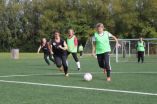(Press-News.org) Jena (Germany) In a chemistry lab at the Friedrich Schiller University Jena (Germany): Prof. Dr. Alexander Schiller works at a rectangular plastic board with 384 small wells. The chemist carefully pipets some drops of sugar solution into a row of the tiny reaction vessels. As soon as the fluid has mixed with the contents of the vessels, fluorescence starts in some of the wells. What the Junior Professor for Photonic Materials does here – with his own hands – could also be called in a very simplified way, the 'sweetest computer in the world'. The reason: the sugar molecules Schiller uses are part of a chemical sequence for information processing.
The chemist of Jena University and his two postgraduate students, Martin Elstner and Jörg Axthelm recently described in the new edition of the science journal 'Angewandte Chemie International Edition' how they developed a molecular computer on the basis of sugar (DOI: 10.1002/anie.201403769). "The binary logic which makes a conventional computer chip work is based on simple yes/no-decisions," Professor Schiller explains. "There is either electricity flowing between both poles of an electric conductor or there isn't." These potential differences are being coded as "0" and "1" and can be linked via logic gates – the Boolean operators like AND, OR, NOT. In this way, a number of different starting signals and complex circuits are possible.
These logic links however can also be realized with the help of chemical substances, as the Jena chemists were able to show. For their 'sugar computer' they use several components: One fluorescent dye and a so-called fluorescence quencher. "If there are both components involved, the colorant can't display its impact and we don't see a fluorescence signal," Schiller says. But if sugar molecules are involved, the fluorescence quencher reacts with the sugar and thus loses its capability to suppress the fluorescence signal, which makes the dye fluorescent. Depending on whether the dye, the fluorescence quencher and the sugar are on hand to give the signal, a fluorescent signal results – "1" – or no signal – "0".
"We link chemical reactions with computer algorithms in our system in order to process complex information," Martin Elstner explains. "If a fluorescence signal is registered, the algorithm determines what goes into the reaction vessel next." In this way signals are not translated and processed in a current flow, like in a computer but in a flow of matter.
That their chemical processing platform works, Schiller and his staff demonstrated in the current study with the sample calculation 10 + 15. "It took our sugar computer about 40 minutes, but the result was correct," Prof. Schiller says smiling, and clarifies: "It is not our aim to develop a chemical competition to established computer chips." The chemist rather sees the field of application in medical diagnostics. So it is for instance conceivable to connect the chemical analysis of several parameters of blood and urine samples via the molecular logic platform for a final diagnosis and thus enable decisions for therapies.
INFORMATION:
Original Publication:
Elstner M, Axthelm J, Schiller A. „Sugar-based molecular computing via material implication", Angewandte Chemie, International Edition 2014, DOI: 10.1002/anie.201403769; German version: Elstner M, Axthelm J, Schiller A. „Zucker-basierter molekularer Rechner mit Implikationslogik", Angewandte Chemie 2014, DOI: 10.1002/ange.201403769.
Contact:
Prof. Dr. Alexander Schiller
Institute for Inorganic and Analytical Chemistry
Friedrich Schiller University Jena
Humboldtstraße 8, 07743 Jena
Phone: ++49 3641 948113
Email: alexander.schiller@uni-jena.de
The sweetest calculator in the world
Chemists of Jena University let fluorescent sugar sensors 'calculate'
2014-06-19
ELSE PRESS RELEASES FROM THIS DATE:
Cochrane Review -- Effectiveness of antimicrobial drugs to treat cholera
2014-06-19
Researchers from the Cochrane Infectious Diseases Group, co-ordinated through the editorial base in LSTM, conducted an independent review of the effects of treating cholera with antimicrobial drugs, published in The Cochrane Library today.
Cholera is an acute watery diarrhoea caused by infection with the bacterium Vibrio cholerae, which can cause rapid dehydration and death. Effective treatment requires early diagnosis and rehydration using oral rehydration salts or intravenous fluids. This review looked at the effects of adding antimicrobial drugs to this treatment.
Thirty-nine ...
Synaptic levels of clathrin protein are important for neuronal plasticity
2014-06-19
Researchers of the group of cellular and molecular neurobiology of the Bellvitge Biomedical Research Institute (IDIBELL) and the University of Barcelona, led by researcher Artur Llobet, have shown that synaptic levels of the protein clathrin are a determinant factor for synaptic plasticity of neurons.
Chemical synapses and synaptic vesicular transmission cycle
Neurons transmit information in a specialized contact points called synapses. These structures consist of two elements: the presynaptic one, information donor, and postsynaptic, which receives the information. In ...
Children consuming a Mediterranean diet are 15 percent less likely to be overweight
2014-06-19
A study of 8 European countries presented at this year's European Congress on Obesity (ECO)in Sofia, Bulgaria, shows that children consuming a diet more in line with the rules of the Mediterranean one are 15% less likely to be overweight or obese than those children who do not.
The research is by Dr Gianluca Tognon, University of Gothenburg, Gothenburg, Sweden, and colleagues across the 8 countries: Sweden, Germany, Spain, Italy, Cyprus, Belgium, Estonia and Hungary.
The researchers used data from the IDEFICS study (Identification and Prevention of Dietary – and lifestyle ...
Recreational football reduces high blood pressure in mature women
2014-06-19
The World Cup in Brazil may be attracting a global armchair audience of millions, but new research has shown that playing football could help lower blood pressure in women aged 35-50.
Women within this age group with mild high blood pressure achieve a significant reduction in blood pressure and body fat percentage through playing recreational football for 15 weeks. This is the finding of a new study conducted in a collaboration between researchers across four countries, including Professor Peter Krustrup of the University of Exeter.
The acclaimed Scandinavian Journal ...
MA healthcare reform does not have early impact on disparities in cardiovascular care
2014-06-19
New research by the Brigham and Women's Hospital, in partnership with Howard University College of Medicine, explores the effect of healthcare reform in Massachusetts on coronary intervention and mortality in adults by race/ethnicity, gender and the level of education in the neighborhood where the patient resides.
Published in the June 17, 2014, issue of Circulation, the journal of the American Heart Association, these findings indicate that healthcare reform in Massachusetts has not yet impacted the likelihood of receiving coronary interventions by gender, race/ethnicity ...
Study offers evidence that sunscreen use in childhood prevents melanoma in adults
2014-06-19
SAN ANTONIO, June 19, 2014 – Research conducted at the Texas Biomedical Research Institute, published in the latest issue of the scientific journal Pigment Cell and Melanoma, has established unequivocally in a natural animal model that the incidence of malignant melanoma in adulthood can be dramatically reduced by the consistent use of sunscreen in infancy and childhood.
According to senior author John L. VandeBerg, Ph.D., the research was driven by the fact that, despite the increasing use of sunscreen in recent decades, the incidence of malignant melanoma, the most ...
Football improves strength in men with prostate cancer
2014-06-19
Men with prostate cancer aged 43‒74 achieve bigger and stronger muscles, improve functional capacity, gain positive social experiences and the desire to remain active through playing football for 12 weeks. These are the findings of the "FC Prostate" trial, jointly conducted by the University Hospitals Centre for Health Care Research at The Copenhagen University Hospital, Rigshospitalet and the Copenhagen Centre for Team Sport and Health at the University of Copenhagen.
Some of the participants in the FC Prostate Cancer research project after a training session. ...
Following direction: How neurons can tell top from bottom and front from back
2014-06-19
TORONTO – The question of how neurons and their axons establish spatial polarity and direction in tissues and organs is a fundamental question of any organism or biological system. Our cells and axons precisely orient themselves in response to external cues, but what are the core pathways and how are they integrated?
Lead author Dr. Naomi Levy-Strumpf and principal investigator Dr. Joseph Culotti developed a novel conceptual framework, published on-line in PLoS GENETICS, June 5 2014.
They investigated netrin and Wnt, signaling pathways that are implicated in cancer ...
Telephone call is effective support when breast cancer treatment includes weight loss
2014-06-19
TORONTO – A series of simple telephone calls can make a profound difference in helping women to meet their treatment goals for breast cancer, according to a randomized trial of women who are also obese, published online today in Journal of Clinical Oncology by Dr. Pamela Goodwin of Mount Sinai Hospital and the Lunenfeld-Tanenbaum Research Institute.
Women who received advice about weight loss from a trained lifestyle coach by telephone achieved weight loss that was still evident after two years, lowering their risk of breast cancer recurrence.
It's already known that ...
Evolution depends on rare chance events, 'molecular time travel' experiments show
2014-06-19
Chance events may profoundly shape history. What if Franz Ferdinand's driver had not taken a wrong turn, bringing the Duke face to face with his assassin? Would World War I still have been fought? Would Hitler have risen to power decades later?
Historians can only speculate on what might have been, but a team of evolutionary biologists studying ancient proteins has turned speculation into experiment. They resurrected an ancient ancestor of an important human protein as it existed hundreds of millions of years ago and then used biochemical methods to generate and characterize ...
LAST 30 PRESS RELEASES:
Press registration is now open for the 2026 ACMG Annual Clinical Genetics Meeting
Understanding sex-based differences and the role of bone morphogenetic protein signaling in Alzheimer’s disease
Breakthrough in thin-film electrolytes pushes solid oxide fuel cells forward
Clues from the past reveal the West Antarctic Ice Sheet’s vulnerability to warming
Collaborative study uncovers unknown causes of blindness
Inflammatory immune cells predict survival, relapse in multiple myeloma
New test shows which antibiotics actually work
Most Alzheimer’s cases linked to variants in a single gene
Finding the genome's blind spot
The secret room a giant virus creates inside its host amoeba
World’s vast plant knowledge not being fully exploited to tackle biodiversity and climate challenges, warn researchers
New study explains the link between long-term diabetes and vascular damage
Ocean temperatures reached another record high in 2025
Dynamically reconfigurable topological routing in nonlinear photonic systems
Crystallographic engineering enables fast low‑temperature ion transport of TiNb2O7 for cold‑region lithium‑ion batteries
Ultrafast sulfur redox dynamics enabled by a PPy@N‑TiO2 Z‑scheme heterojunction photoelectrode for photo‑assisted lithium–sulfur batteries
Optimized biochar use could cut China’s cropland nitrous oxide emissions by up to half
Neural progesterone receptors link ovulation and sexual receptivity in medaka
A new Japanese study investigates how tariff policies influence long-run economic growth
Mental trauma succeeds 1 in 7 dog related injuries, claims data suggest
Breastfeeding may lower mums’ later life depression/anxiety risks for up to 10 years after pregnancy
Study finds more than a quarter of adults worldwide could benefit from GLP-1 medications for weight loss
Hobbies don’t just improve personal lives, they can boost workplace creativity too
Study shows federal safety metric inappropriately penalizes hospitals for lifesaving stroke procedures
Improving sleep isn’t enough: researchers highlight daytime function as key to assessing insomnia treatments
Rice Brain Institute awards first seed grants to jump-start collaborative brain health research
Personalizing cancer treatments significantly improve outcome success
UW researchers analyzed which anthologized writers and books get checked out the most from Seattle Public Library
Study finds food waste compost less effective than potting mix alone
UCLA receives $7.3 million for wide-ranging cannabis research
[Press-News.org] The sweetest calculator in the worldChemists of Jena University let fluorescent sugar sensors 'calculate'



